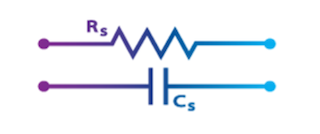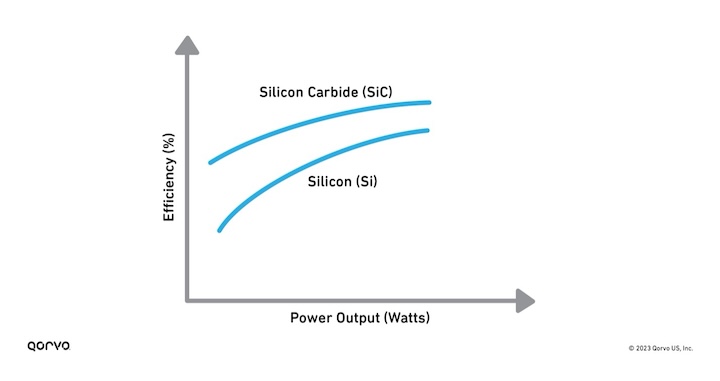The Transition from Si to SiC in Power Electronics
December 4, 2023
Power electronics like Si MOSFETs, SiC MOSFETs, GaN HEMTs or SiC FETs are the main technological building blocks used in many market areas. For a long time, Si has been the semiconductor material of choice in power electronics applications. Recently, there has been a shift away from Si to SiC devices, mostly due to the significant improvements in the performance and reliability of SiC technology.
The performance advantages offered by SiC have been life-changing in many power-electronic markets; electric vehicles, white goods, infrastructure, solar energy/renewables, data centers, and more. With SiC’s larger bandgap energy (i.e., 3.3eV, as opposed to Si’s 1.1eV – see Figure 2) and its higher breakdown voltage, SiC can be exploited to create newer, higher-performance solutions.
Today, manufacturers have adopted SiC technology to develop power electronic modules based on various semiconductor devices, such as bipolar junction transistors (BJTs), junction gate field effect transistors (JFETs) and metal oxide semiconductor field effect transistors (MOSFETs). In the following sections we explore why SiC is becoming a breakthrough power electronic technology of the future.
The Advantages of Using SiC Versus Si
To begin, SiC MOSFETs, or SiC FETs, have several advantages over Si devices. For starters, SiC has a much higher breakdown voltage, meaning a much thinner device can be used to support higher voltages. Other advantages of SiC over Si are:
Need Help with Your Designs?

Visit the SiC FET Design Tips Site, which provides a variety of resources—from user guides to videos and webinars—to help you build the best products.
- It is a wide bandgap material, making the leakage current lower at high temperatures.
- Has a higher thermal conductivity that helps it support high-current density applications.
- Has a lower energy loss, helping it to minimize power losses.
- Has a higher switching frequency, which reduces bulky large periphery components.
- Has lower switching losses due to its smaller die size and reduced parasitic capacitances, allowing the power converters to operate at higher switching frequencies and speeds.
- Offers higher temperature operation, helping reduce large mechanical heat sinks. So, we can now see how the SiC device has many advantages over its Si counterpart. This is why many applications are moving from Si to using SiC.
Understanding the Electro-thermal Advantages
In power electronics, providing high power levels in a very efficient way while minimizing power loss is important. Meeting extreme thermal requirements is also very important. SiC offers these and low drain-to-source RDS(ON) 300 to 400 times lower than Si devices. This figure-of-merit (FOM) provides technology manufacturers with a desirable feature for designing efficient power electronics equipment. Additionally, SiC can manage higher power levels than Si in the same active die area – allowing for devices with the same performance level in a reduced dimension.
Moreover, SiC offers high electro-thermal conductivity and fast switching. It also has low output capacitance and RDS(ON). Because it can handle high energy levels and with much higher switching frequencies, it enables significant system cost savings for manufacturers. Why? Because these FOMs translate to the downsizing of magnetic parts like transformers, chokes and inductors used in all switching mode designs. All these FOMs make it well suited for switching designs in applications like three-phase inverters, digital power supplies and electronic (AC/DC and DC/DC) converters.
One of the FOMs that manufacturers seek today is efficiency. This is a major drive in many applications due to a global push for ‘green’ energy initiatives. As shown below, Figure 1 displays how more efficient SiC is over Si. Making it a go-to technology in many of today’s next-generation designs.

Wide bandgap semiconductor technologies like SiC are ideal for next-generation efficient power electronics. (See Figure 2) SiC offers excellent voltage-blocking capabilities starting at 650 V and provides even greater benefits at higher voltages. One key initiative in next-generation solutions is “green” systems (i.e., energy-efficient). SiC provides this capability – its wide bandgap ability allows for greater power efficiency, smaller size, lighter weight and lower overall cost – equating to “greener” solutions.
.jpg?la=en&hash=CA20A9F553DAC0E7E165DD1C17234BDF663B4864)
Some Final Takeaways
We now have a better understanding of how Si compares to SiC. Both have a place in our new digital world in many applications. But in many solutions, SiC has clearly excelled. SiC technology can be used in a wide range of power electronic solutions. Using SiC in applications like high-frequency DC/DC and AC/DC offers many benefits due to the wide operating gate drive range. Additionally, using SiCs in electric vehicle inverters, one can achieve low conduction losses and robust short-circuit handling.
Further, evolutionary SiC achievements will catapult this technology into more applications – while opening others. Moreover, progress in package design, market acceptance and fast-growing markets will push SiC further into even more solutions.
For more on this topic and solutions for your latest design challenge, visit the Qorvo Design Hub for a rich assortment of videos, blog articles, white papers, tools and more.
For more information about this and other Qorvo power solutions, please visit Qorvo.com or reach out to Technical Support.
Have another topic that you would like Qorvo experts to cover? Email your suggestions to the Qorvo Blog team and it could be featured in an upcoming post. Please include your contact information in the body of the email.